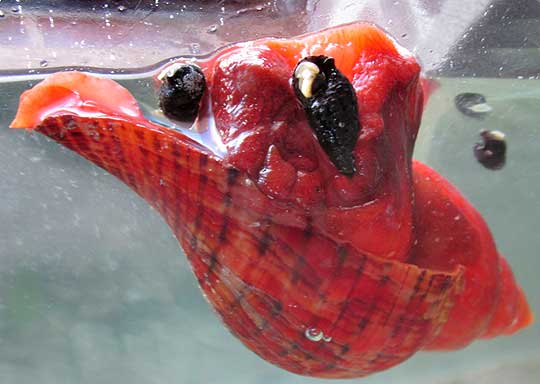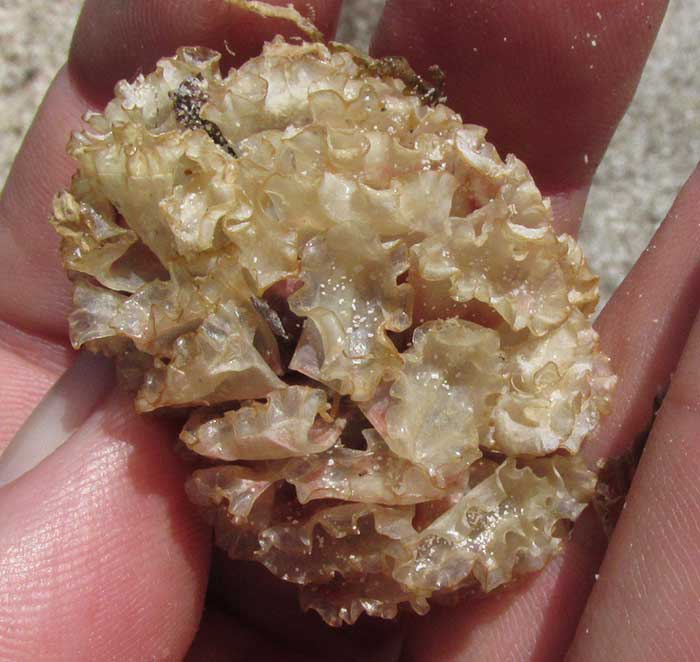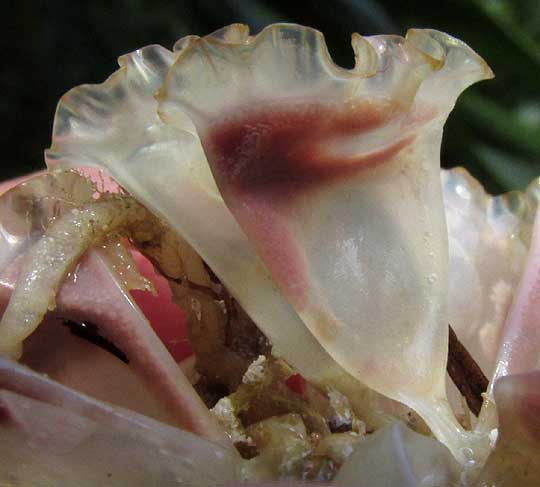Excerpts from Jim Conrad's
Naturalist Newsletter

from the March 22, 2015 Newsletter issued from Río Lagartos, on the Yucatan Peninsula's northern coast (~N21.60°, ~W88.16°), Yucatán state, MÉXICO
TRUE TULIP
In Ría Lagartos's shallow, brackish waters True Tulip's egg cases turn up fairly regularly, so I wasn't surprised when a True Tulip itself appeared in the aquarium being put together at restaurant/ecotour headquarters. What did surprise me was that the 2½-inch long (6.5cm) gastropod was so brilliantly red. Above, you can see the critter moving along the aquarium's sandy bottom. Another shot showing him at the water's surface appears below:

In that picture the tulip's fleshy parts are wrapping around a smaller, dark snail. We may be seeing more than the clumsy passage of a big snail over a smaller one. True Tulips are voracious predators and feed on a variety of clam-like bivalves and gastropods like themselves. The tulip seems to be trying to dislodge the smaller snail from the aquarium wall so it can be eaten.
I read that three species of tulip sea-snails occur in the Gulf of Mexico. Though pictures of tulip-type sea-snails -- species of the genus Fasciolaria -- are easy to find on the Internet, of the hundreds I've looked at not a single shell was as vibrantly and completely red as ours.
However, at the website of the Gulf States Marine Fisheries Commission in a PDF draft document by Perry & Larsen entitled Guide to Shelf Invertebrates, Gulf of Mexico, I read that with regard to the True Tulip, "A beautiful orange-red color variety is not uncommon on the Lower Florida Keys and Yucatan. Giants reach a length of 10 inches."
So, just with photographs I can't determine which tulip species this is, but since so many True Tulip egg cases turn up here, and it's known that a beautiful, orange-red variety turns up in the Yucatan, I'm guessing that our pictures show the orange-red variety of the True Tulip, Fasciolaria tulipa.
True Tulips turn up from North Carolina on the US southeastern coast south through the Gulf of Mexico and Caribbean to the coasts of northern South America and Brazil, and from what I can see on the Internet, our Yucatan ones are the brightest, prettiest of the bunch.

from the December 14, 2014 Newsletter issued from Río Lagartos, on the Yucatan Peninsula's northern coast (~N21.60°, ~W88.16°), Yucatán state, MÉXICO
TRUE TULIP EGG CASES
After the last strong norte blew from the north for several days, the sea-side beach of the slender finger of land separating Ría Lagartos Estuary from the Gulf of Mexico was heaped knee deep with tons and tons of washed up seaweed and other goodies. One of the most curious and, for me, mysterious washed-up items on the beach was the white, pine-cone-like item shown above. Individual sections of the washed-up object were not at all woody and stiff like pine-cone scales, though. Their tops were like shiny plastic bowls with frilly rims, as seen below:

The parts were bladder-like, shaped like white urns made of thin, translucent porcelain, but they felt rubbery, and were splotched with an interior-seeming raspberry hue, as you can see below:

At first I thought that this was some kind of freely floating alga depending on air-filled bladders for dispersal, which was the case with the Turbinaria alga we found on the Caribbean coast a while back. You can compare our current find with that alga at www.backyardnature.net/yucatan/turbinar.htm.
However, on the Internet no Turbinaria-like alga could be found looking like our washed-up discovery. Also, the object's parts looked too membranous and elegant to be of algal origin.
Eventually something else we once found on the Caribbean coast came to mind, something also formed of strung-together parts of animal origin. You can see that at www.backyardnature.net/yucatan/whelk.htm.
That's a Whelk egg-case, a Whelk being a medium to large, snail-like, marine mollusk. With the insight that our norte-delivered discovery might be a mollusk egg-case, finally pictures matching our discovery were found on the Internet. They were labeled as egg cases of the True Tulip, FASCIOLARIA TULIPA.
True Tulips are medium-sized, predatory, gastropod-type mollusks whose shells are whitish to tan, with rows of darker brownish blotches of various sizes. They're called tulips because the shells' overall shape supposedly looks like a closed tulip flower. Several species of the genus Fasciolaria are called tulips, but Fasciolaria tulipa is the "true" one, named by Linnaeus in 1758.
True Tulips are described as living in sand flats and seagrass beds at depths normally less than 30 feet (9m). They prey on bivalves such as clams as well as various other gastropods, including the closely related Banded Tulip and the over-hunted, vanishing Queen Conch. True Tulips turn up from North Carolina on the US southeastern coast south through the Gulf of Mexico and Caribbean to the coasts of northern South America and Brazil.